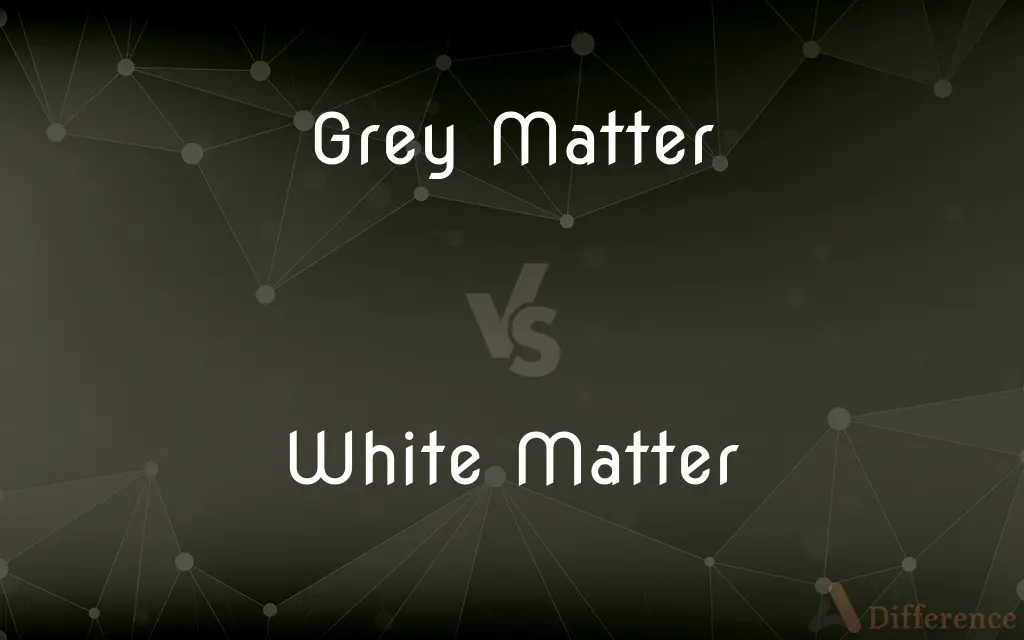Grey Matter vs. White Matter — What's the Difference?
By Fiza Rafique & Maham Liaqat — Published on March 6, 2024
Grey matter consists of neuron cell bodies, crucial for processing information in the brain. White matter contains myelinated axons, facilitating communication between different brain regions.

Difference Between Grey Matter and White Matter
Table of Contents
ADVERTISEMENT
Key Differences
Grey matter is found in the brain's outer layer and within certain areas inside, including the cerebral cortex and basal ganglia. It plays a pivotal role in processing and interpreting information received from the sensory organs and in controlling movement. This processing capability is crucial for decision-making, memory, emotions, and speech. On the other hand, white matter lies beneath the grey matter and consists of myelinated axons, which are nerve fibers covered by myelin sheaths. These myelinated axons speed up the transmission of electrical signals between neurons, enabling efficient communication across different parts of the brain and spinal cord.
The distribution of grey and white matter varies throughout the brain. Grey matter is densely packed with neuron cell bodies, dendrites, and synapses, making it the hub for information processing and synaptic activity. In contrast, white matter's primary function is to connect these processing centers, ensuring that signals can travel quickly and efficiently. This structural organization supports the brain's complex functions, from basic survival instincts to advanced cognitive processes.
The density of grey matter can change over an individual's lifetime, influenced by various factors such as learning, experience, and aging. Activities that stimulate the brain, like learning a new skill or language, can lead to increases in grey matter density in relevant areas of the brain. Conversely, white matter's integrity can be affected by aging, leading to slower cognitive processing speeds as the quality of myelin sheaths deteriorates over time.
Imaging techniques such as MRI have revealed differences in the volume and distribution of grey and white matter in individuals with certain neurological and psychiatric conditions, highlighting the importance of both types of brain matter in mental health. For example, alterations in grey matter volume have been associated with disorders like schizophrenia and Alzheimer's disease, while changes in white matter connectivity have been linked to depression and autism.
Understanding the distinct roles of grey and white matter is crucial for neuroscience and medicine. Grey matter's involvement in processing and decision-making is complemented by white matter's role in communication and signal transmission, illustrating the brain's complexity and the interdependence of its different parts.
ADVERTISEMENT
Comparison Chart
Composition
Neuron cell bodies, dendrites, synapses
Myelinated axons
Function
Processes information, controls movements, memory, emotions
Facilitates communication between brain regions
Location
Outer layer of the brain and certain areas inside
Beneath the grey matter, throughout the brain and spinal cord
Role in the Brain
Information processing and synaptic activity
Signal transmission speed and efficiency
Changes Over Lifetime
Can increase with learning, decreases with aging
Integrity can deteriorate with aging
Health Implications
Changes in density linked to various mental health conditions
Alterations in connectivity associated with mental disorders
Compare with Definitions
Grey Matter
Influences decision-making and speech.
Bilingual individuals show denser grey matter in areas relevant to language.
White Matter
Ensures efficient signal transmission across the brain.
Professional gamers may have optimized white matter pathways for faster reaction times.
Grey Matter
Crucial for cognitive functions and emotional regulation.
Meditation has been shown to increase grey matter density in areas related to stress regulation.
White Matter
Connects different brain regions for integrated functioning.
White matter tracts are vital for coordinating sensory and motor responses.
Grey Matter
Subject to change through learning and experience.
Musicians often have increased grey matter in regions involved in musical processing.
White Matter
Affected by aging and lifestyle.
Physical exercise can help maintain white matter integrity into old age.
Grey Matter
The brain's processing center, rich in neuron cell bodies.
Increased grey matter in the hippocampus is associated with better memory.
White Matter
Comprises myelinated axons facilitating brain communication.
Healthy white matter is crucial for quick reflexes.
Grey Matter
Impacted by neurological disorders.
Grey matter atrophy is a hallmark of Alzheimer's disease.
White Matter
Alterations linked to psychiatric conditions.
White matter abnormalities are observed in individuals with schizophrenia.
Common Curiosities
What happens to white matter as we age?
Its integrity can deteriorate, potentially slowing cognitive processing speeds.
Why is grey matter important?
It's essential for processing sensory information, controlling movements, and executing cognitive functions.
What is the main difference between grey matter and white matter?
Grey matter processes information, while white matter facilitates communication between brain regions.
How are changes in grey and white matter detected?
Through imaging techniques like MRI, which can reveal volume and connectivity changes.
Are grey and white matter affected by mental health conditions?
Yes, alterations in both can be linked to various neurological and psychiatric conditions.
How does white matter contribute to brain function?
It speeds up signal transmission, enabling efficient communication across different parts of the brain.
Is it possible to increase grey matter density?
Yes, through activities that stimulate the brain, such as learning and meditation.
Can lifestyle choices affect the health of grey and white matter?
Yes, activities like physical exercise and learning can impact their health and functionality.
Can the brain's grey matter change over time?
Yes, it can change based on learning, experiences, and aging.
What role does myelin play in white matter?
Myelin sheaths around axons increase the speed of electrical signal transmission.
How do grey and white matter interact in the brain?
Grey matter processes information which is then communicated through the white matter's network, integrating brain functions.
How does the brain compensate for white matter damage?
The brain can sometimes reroute communications through alternative pathways, though this may not fully restore function.
What implications do changes in white matter have for mental disorders?
Changes in connectivity can affect cognitive and emotional processing, relevant to disorders like depression and autism.
What causes white matter to deteriorate?
Aging, lack of physical activity, and certain diseases can lead to deterioration.
Can changes in grey matter affect emotions?
Yes, since grey matter is involved in emotional regulation, changes can impact mood and feelings.
Share Your Discovery

Previous Comparison
Green Goblin vs. Hobgoblin
Next Comparison
Piaget Theory vs. Vygotsky TheoryAuthor Spotlight
Written by
Fiza RafiqueFiza Rafique is a skilled content writer at AskDifference.com, where she meticulously refines and enhances written pieces. Drawing from her vast editorial expertise, Fiza ensures clarity, accuracy, and precision in every article. Passionate about language, she continually seeks to elevate the quality of content for readers worldwide.
Co-written by
Maham Liaqat















































